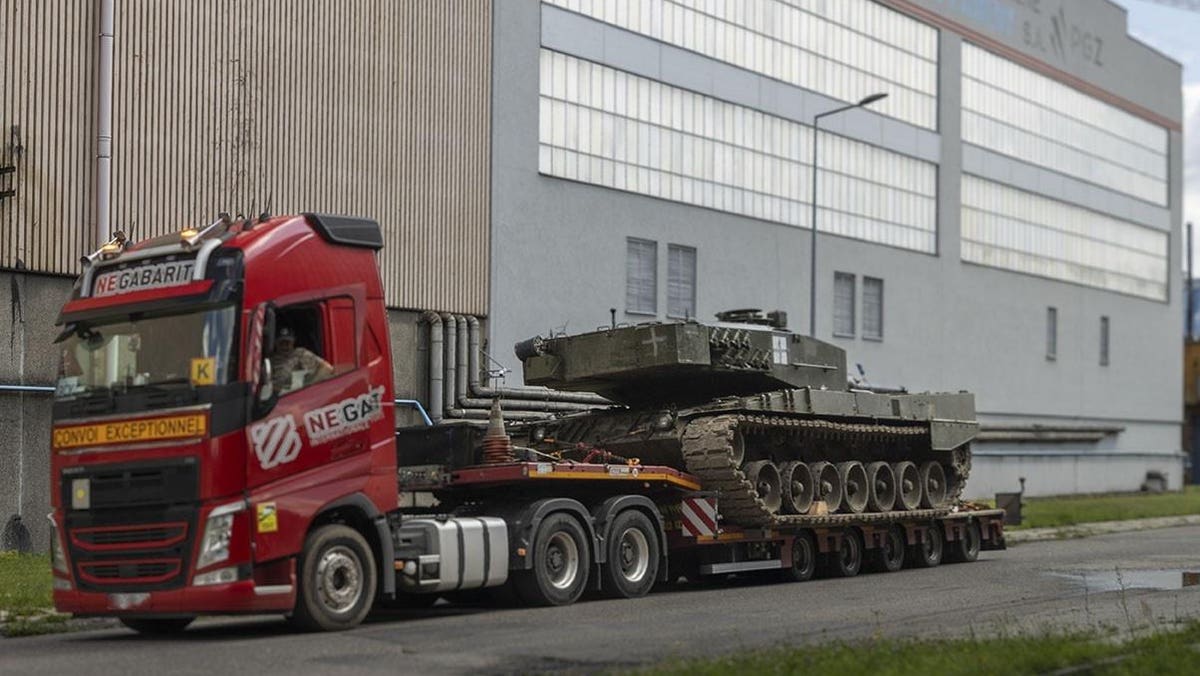In just the first two years of Russia’s wider war on Ukraine, Kyiv’s foreign allies pledged to the Ukrainian war effort no fewer than 3,000 modern tanks, fighting vehicles and armored trucks.
Now Ukraine’s allies need to focus on repairing these vehicles. Speedy repairs might make all the difference as Russia’s wider war on Ukraine lurches toward its third year.
The thousands of Western-made tanks, fighting vehicles and armored trucks fully or partially have equipped around half of Ukraine’s front-line brigades—and, along with NATO-style training, have inspired a whole new way of thinking in the armed forces’ staffs and regional commands.
When their troops strictly operated Soviet-designed vehicles and followed Soviet doctrine, Ukrainian commanders assumed that losing a vehicle also meant losing its occupants—the crew plus any infantry riding inside.
But Western vehicles are “designed for the people,” said one Ukrainian crew member of a British Challenger 2 tank. With tougher armor, fire-proofing and ammunition stowage that minimizes the chances of a catastrophic explosion, these vehicles are more likely to get immobilized while sparing their occupants major harm, than they are to get destroyed along with their occupants.
And that’s why, three months into their widely-anticipated southern counteroffensive, Ukrainian brigades are losing a lot of vehicles—damaged, at least—but aren’t losing a lot of the people who were inside these vehicles.
Crews and passengers bail out of their immobilized rides and, fleeing to the rear, climb into replacement vehicles in order to stay in the fight while their former mounts undergo repairs. “I spoke with a soldier who survived two direct hits on [an American-made] Bradley [fighting vehicle] during shelling,” Ukrainian soldier Olexandr Solon’ko wrote.
That has the effect of preserving Ukrainian forces’ human capital: their training and experience. But it also places the onus on Ukraine’s allies to help repair battle-damaged vehicles and maintain Ukrainian brigades’ front-line strength.
Analysts Jack Watling and Nick Reynolds noted this technology-driven shift in thinking in their latest study for the Royal United Services Institute in London. “Ukrainian troops note that Western-provided platforms are vastly superior to their Soviet-legacy protected mobility platforms for one fundamental reason: crew survivability,” Watling and Reynolds wrote.
“There is a heavy emphasis in Western platforms on the survivability of dismounts even if the vehicle is mission-killed,” the analysts continued. “By contrast, with Soviet-legacy platforms, the compromise of the vehicle’s armor is also usually catastrophic for those inside it. Life support systems are a secondary consideration.”
Leaving aside the moral and ethical considerations, this dichotomy matters because Russian forces greatly outnumber Ukrainian forces. “Given that Russia has greater mass than Ukraine, the accumulation of experience and longevity of troops is strategically vital for the [armed forces of Ukraine,” according to Watling and Reynolds.
Seemingly insensitive to the human cost of their weapons-design philosophy, Russian commanders write off vehicles, bury their crews—and simply replace them with identical vehicles and freshly-mobilized personnel. If the military price of that mindset is the loss of the crews’ training and experience … well, so be it.
Different ways of thinking demand different material processes. As they deploy disposable vehicles and crews on one-way missions, the Russians need a large reserve of replacement vehicles and crews. Fortunately for them, Russia’s storage bases still contain tens of thousands of Soviet-vintage armored vehicles. And Russia’s outlying oblasts still hold significant reserves of manpower.
The Ukrainians by contrast need recovery vehicles, access to repair depots and plenty of spare parts. The same toughness that helps Ukraine’s German-made Leopard 2 tanks and American-made Bradley fighting vehicles to protect their crews also means they tend to get damaged instead of destroyed.
But a damaged and abandoned vehicle stays damaged and abandoned until engineers tow it off the battlefield and mechanics fix it up near the front line, or ship it off to a foreign depot for major rework. “Even the most critically damaged equipment is recovered and taken for repairs,” Solon’ko wrote.
The recovery process is arduous, Solon’ko stressed. “They hunt for evacuation teams—both vehicles and stations,” he wrote about the Russians. “Right under our noses, they hit an armored vehicle, and an evacuation vehicle arrived for the guys. They had to maneuver in a tight spot, moving very slowly on a narrow road, avoiding going off-road into a mined field. Taking risks as well.”
It’s not for no reason that Ukraine has reactivated scores of ex-Soviet armored recovery vehicles—and acquired scores of additional ARVs from Germany, the United Kingdom, the United States and other allies. The Ukrainians need every recovery vehicle they can get their hands on as more and more highly-survivable Western tanks and fighting vehicles get immobilized on the front line then just sit there, waiting for retrieval and repair.
By the same token, the Ukrainians require huge consignments of spare parts so they can fix lightly-damaged vehicles all on their own, Watling and Reynolds explained. “That is challenging for vehicles that are no longer in production. Again, therefore, Ukraine’s international partners need to ensure that the industrial support is available to make the Ukrainian military sustainable.”
That applies to depots, too, where foreign workers can do the deep repairs and maintenance that some Ukrainian motor-pool sergeant can’t do in his brigade’s rear area. Poland is fixing Ukraine’s Leopard 2A4 tanks and Bradley fighting vehicles; Germany is repairing the newer Leopard 2A6s. As damaged vehicles pile up, Ukraine might need access to more repair facilities.
Fixing Ukraine’s armored vehicles, many more than once, should be a top priority as Kyiv’s allies look ahead to the coming winter—and the spring and summer to follow. As serious as Ukraine’s repair needs are right now, they’re about to get worse.
“It is now clear that the conflict will protract,” Watling and Reynolds wrote. “It is therefore important that Ukraine’s international partners invest now to give Ukraine protracted advantages. Failure to make timely adjustment to support will come at a heavy price in 2024.”
Read the full article here





